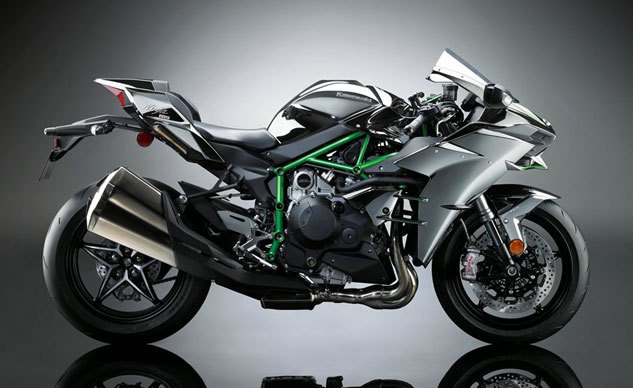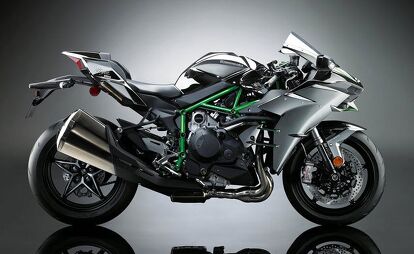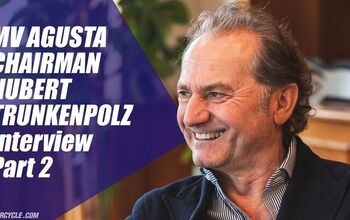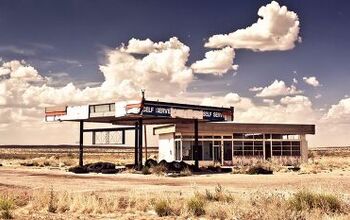2014 EICMA: 2015 Kawasaki Ninja H2 Preview

After one of the lengthiest teaser campaigns in recent memory, Kawasaki has revealed the Ninja H2, the street-legal version of its track-only Ninja H2R. The $25,000 2015 Kawasaki Ninja H2 will be produced in small numbers with dealers accepting deposits up until Dec. 19 on a first-come, first-served basis.
Discuss this at our Kawasaki Ninja H2 Forum.
The Ninja H2 uses a similar supercharged 998cc engine as the H2R but with different camshafts, gaskets and clutch. Kawasaki also modified intake and exhaust system to meet noise and emission requirements for street homologation. The supercharger is driven by a planetary gear train connected to the crankshaft using technology from Kawasaki’s aerospace divison. The impeller spins at up to approximately 130,000 rpm while the engine speed tops out more sedately at about 14,000 rpm.
Kawasaki designed the engine to accommodate the higher air pressure of the supercharger, claiming the engine can handle from 1.5 to 2 times the stresses typically met by naturally-aspirated 1000cc engines. The pistons are cast instead of forged to better handle the higher temperatures of the supercharged engine. The intake valves are stainless steel while the exhaust valves are a more heat-resistant alloy called Inconel friction-welded to steel valve stems.
To keep the engine cool, Kawasaki uses a combination of liquid and oil cooling. The radiator is about the same size as those on conventional liter-class sportbikes but it flows 1.5 times more air. This allowed Kawasaki to increase its effectiveness without increasing its size. Oil is used to both cool and lubricate the supercharger and transmission. Jets spray oil on the supercharger’s chain where it meets both the upper and lower sprockets, while an oil passage is used on the supercharger’s lower gear. An additional two air jets cool each cylinder while the transmission also uses oil jets. To meet these needs, the Ninja H2 holds 1.3 gallons of oil, about 35% more than typical naturally-aspirated engines.
Kawasaki equipped the H2 with a three-mode traction control system tuned for the track, the street or wet road conditions. Each mode has an additional three levels for a total of nine traction control settings (or 10, if you include “off”.) For even wetter conditions, the H2 has a Rain mode which increases traction control intervention while reducing engine output by 50% and easing throttle response.
Other technological features include a quickshifter, a three-mode launch control, a reduced engine braking mode and the Kawasaki Intelligent Anti-lock Brake System (KIBS). Based on the system used on the ZX-10R, KIBS suppresses rear lift, reduces kickback and accounts for back torque.
The engine is mounted in a similar trellis frame as the H2R, designed to balance stiffness and flexibility while allowing engine heat to dissipate.
The 43mm KYB Air-Oil Separate II cartridge fork offers adjustable spring preload and rebound and compression damping with 4.7 inches of travel. KYB also supplies the fully-adjustable rear shock which mounts to a revised Uni-Trak linkage system to the single-sided swingarm.
The front wheel is equipped with a pair of 330mm semi-floating Brembo brake discs. The discs are 5.5 mm thick and are grooved to increase surface area for better cooling. Brembo also supplies the radial-mount cast aluminum monobloc calipers with 30mm pistons. A two-piston caliper stops the 250mm rear brake disc.
The Ninja H2 lacks the H2R’s wings but keeps the chin spoiler for added downforce. The mirrors stick out pretty far to either side and the mounts use an airfoil-shaped cross section with Gurney flaps for more downforce.
Other features include a full LED lighting system, Öhlins electronic steering damper and a special Mirror Coat Black paint that appears black in shadows but is highly reflective in the light.
| 2015 Kawasaki Ninja H2 Specifications | |
|---|---|
| Engine | Liquid-cooled, 4-stroke in-line four |
| Displacement | 998cc |
| Bore x Stroke | 76 x 55mm |
| Compression Ratio | 8.5:1 |
| Fuel System | Fuel injection: 50mm x 4 with dual injection |
| Intake System | Kawasaki supercharger |
| Cooling System | Water-cooled |
| Lubrication | Forced lubrication, wet sump with oil cooler |
| Ignition | Digital |
| Transmission | 6-speed, return, dog-ring |
| Final Drive | Chain |
| Frame Type | Trellis, high-tensile steel, with swingarm mounting plate |
| Rake/Trail | 24.5˚ / 4″ |
| Fuel Capacity | 4.5 gallons |
| Front Suspension / Wheel Travel | 43mm inverted fork with rebound and compression damping, spring preload adjustability and top-out springs / 4.7 |
| Rear Suspension / Wheel Travel | New Uni-Trakwith gas-charged shock, piggyback reservoir, dual-range (high/low-speed) compression damping, rebound damping and preload adjustability, and top-out spring / 5.3″ |
| Front Tire Size | 120/70 ZR17 M/C (58W) |
| Rear Tire Size | 200/55 ZR17 M/C (78W) |
| Front Brakes | Dual radial-mount, opposed 4-piston calipers, dual semi-floating 330mm discs |
| Rear Brakes | Opposed 2-piston calipers, single 250mm disc |
| Overall Length | 82″ |
| Overall Width | 30.3″ |
| Overall Height | 44.3 |
| Overall Height Windscreen Lowered/Raised | N/A |
| Ground Clearance | 5.1″ |
| Seat Height | 32.5″ |
| Curb Weight** | 524.7 lb |
| Wheelbase | 57.3 |
| Color Choices | Mirror Coated Black |
| MSRP | $25,000 |
| Warranty | TBD |
| Kawasaki Protection Plus (optional) | TBD |
| Wholesale Distributor | Kawasaki Motors Corp., U.S.A. 9950 Jeronimo Road, Irvine, California 92618 949-770-0400 www.kawasaki.com |

Dennis has been a part of the Motorcycle.com team since 2008, and through his tenure, has developed a firm grasp of industry trends, and a solid sense of what's to come. A bloodhound when it comes to tracking information on new motorcycles, if there's a new model on the horizon, you'll probably hear about it from him first.
More by Dennis Chung
































































































Comments
Join the conversation
Very nice. Can't afford it. Now, please put the Z1000 back the way it was. Thank you.
25k...lol thats ok id rather spend 15k on a brand new busa and put another 7k in a turbo and put out over 300hp easy and still come out cheaper. ...not impressed. 25k please. they dont need to produce but a small amount cause no one is gonna fork out that kind of money